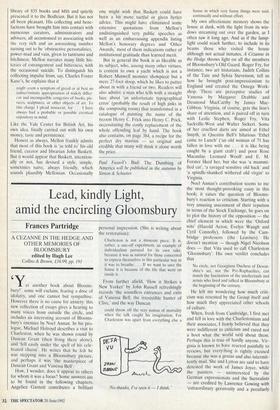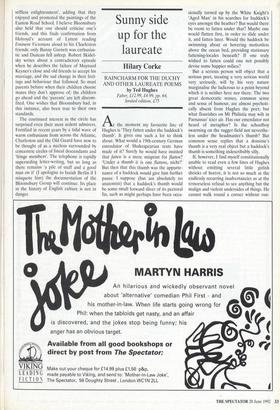Lead, kindly Light, amid the encircling Gloomsbury
Frances Partridge
A CEZANNE IN THE HEDGE AND OTHER MEMORIES OF BLOOMSBURY edited by Hugh Lee Co//ins & Brown, £16.99, pp. 191 Yet another book about Blooms- bury!', some will exclaim, fearing a dose of idolatry, and one cannot but sympathise. However there is no cause for anxiety: this new collection of essays gives a hearing to many voices from outside the circle, and includes an interesting account of Blooms- bury's enemies by Noel Annan. In his pro- logue, Michael Holroyd describes a visit to Charleston, when he was shown round by Duncan Grant (then living there alone), and 'fell easily under the spell of his cele- brated charm'. He writes that he felt he was stepping into a Bloomsbury picture, and perhaps it was 'the masterpiece of Duncan Grant and Vanessa Bell'.
How, 1 wonder, does it appear to others for whom it was a focus? Some answers are to be found in the following chapters. Angelica Garnett contributes a brilliant personal impression. (She is writing about the restoration):
Charleston is not a museum piece. It is, rather, a one-off experiment, an example of individualism pursued for its own sake, because it was as natural for those concerned to express themselves in this particular way as it was to breathe . . If we want to save the house it is because of the life that went on inside it.
From further afield, 'How it Strikes a New Yorker' by John Russell refreshingly records 'the soundless entrances and exits of Vanessa Bell, the irresistible banter of Clive,' and the way Duncan
could throw off the very notion of mortality when the talk caught his imagination. For Charleston was apart from everything else a
'No thanks, I've seen it-- I thill1;.'
house in which very funny things were said, continually and without effort.
My own affectionate memory shows the house at dusk, with the light from its win- dows streaming out over the garden, as I often saw it long ago. And as if the lamp- light could reach further, to include in its beams those who visited the house although not actual inmates, A Ceianne in the Hedge throws light on all the members of Bloomsbury's Old Guard. Roger Fry, for instance; two art historians, Judith Collins of the Tate and Sylvia Stevenson, tell us how he brought post-impressionism to England and created the Omega Work- shop. There are perceptive studies of Vanessa by Margaret Drabble and Desmond MacCarthy by James Mac- Gibbon. Virginia, of course, gets the lion's share of attention, and is paired off in turn with Leslie Stephen, Roger Fry, Vita Sackville-West and Walter Sickert. Some of her cruellest darts are aimed at Ethel Smyth, in Quentin Bell's hilarious 'Ethel came to Lunch' Can old woman of 71 has fallen in love with me . . . it is like being caught by a giant crab') and poor Rose Macaulay. Leonard Woolf and E. M. Forster liked her, but she was 'a mummi- fied cat', 'a ravaged sensitive old hack' and 'a spindle-shanked withered old virgin' to Virginia.
Noel Annan's contribution seems to me the most thought-provoking essay in this book; it raises the question of Blooms- bury's reaction to criticism. Starting with a very amusing assessment of their repution in terms of the Stock Exchange, he goes on to plot the history of the opposition — the chief element in which were the 'Oxford wits' (Harold Acton, Evelyn Waugh and Cyril Connolly), followed by the Cam- bridge professors (the Leavises). He doesn't mention — though Nigel Nicolson does — that Vita used to call Charleston `Gloomsbury'. His own verdict concludes that
No circle, not Georgiana Duchess of Devon- shire's set, not the Pre-Raphaelites, can match the fascination of the intellectuals and artists who lived and talked in Bloomsbury at the beginning of the century.
He left me wondering how much criti- cism was resented by the Group itself and how much they appreciated other schools of culture.
When, fresh from Cambridge, I first met and fell in love with the Charlestonians and their associates, I firmly believed that they were indifferent to criticism and cared not a hoot what the world said about them. Perhaps this is true of hardly anyone. Vir- ginia is known to have reacted painfully to reviews, but everything is rightly excused because she was a genius and also intermit- tently mad. She and Lytton are said to have detested the work of James Joyce, while the painters —. 'uninterested by the German expressionists and the Surrealists — are credited by Lawrence Gowing with 'extraordinary generosity and a peculiarly
selfless enlightenment', adding that they enjoyed and promoted the paintings of the Euston Road School. I believe Bloomsbury also held that one should criticise one's friends, and this finds confirmation from Holroyd's account of Lytton reading Eminent Victorians aloud to his Charleston friends: only Bunny Garnett was enthusias- tic and Duncan fell asleep. Robert Skidel- sky writes about a contradictory episode when he describes the failure of Maynard Keynes's close and old friends to accept his marriage, and the sad change in their feel- ings and behaviour that followed. So must parents behave when their children choose mates they don't approve of the children go ahead and the 'parents' are left discom- fited. One wishes that Bloomsbury had, in this instance, also been true to their own standards.
The continued interest in the circle has surprised even their most ardent admirers. Fortified in recent years by a tidal wave of warm enthusiasm from across the Atlantic, Charleston and the Old Guard have now to be thought of as a nucleus surrounded by concentric circles of lineal descendants and 'fringe members'. The telephone is rapidly superseding letter-writing, but so long as there remains 'a pile of stuff and a good man on it' (I apologise to Isaiah Berlin if I misquote him) the documentation of the Bloomsbury Group will continue. Its place in the history of English culture is not in danger.



























































 Previous page
Previous page